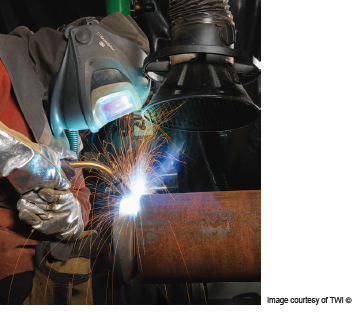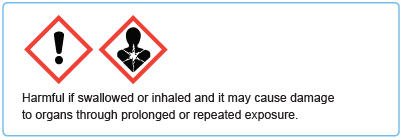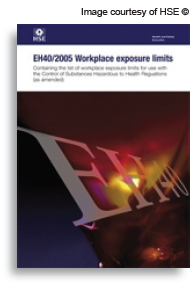Welding processes generate emissions of very fine particles known as welding fume.
The fume is made up of lots of different kinds of substances, most of which are hazardous to your health. One common component of the fume is manganese, which has been shown to cause adverse effects to the nervous system. The arc welding process also generates gases such as carbon monoxide and ozone. Different processes generate differing amounts of fume, e.g. tungsten inert gas (TIG) welding produces less fume than manual metal arc (MMA) welding. Welders can be exposed to the fume from the welding operation unless suitable controls are put in place, such as local exhaust ventilation (LEV) or respiratory protection.

Manganese is a metal and is a constituent part of steel and welding rods
The material being welded and the welding rods contain many substances, one of them is manganese (Mn). There is growing concern regarding the impact of this metal on human health and the current workplace exposure limit was significantly reduced in 2018. Many steels contain levels of manganese of up to 2.5% and special grades can contain up to 12.5%. Welding rods contain as much as 12.5% manganese as this helps the flux flow freely.
Some stainless steels replace nickel with manganese.
Manganese is used in welding rods because it helps the flux flow easily. This is due to the low boiling point of manganese compared to iron (1962°C compared to 2750°C). Because of this, it is likely that there will be more manganese in welding fume than expected from the composition of the rod or the steel (as described in the safety data sheet for the welding rods). In addition, the manganese is more likely to be respirable – that is its very small particles can penetrate to the deep sections of the lung.
Of course manganese is not the only hazard associated with welding.
Assessments under the Control of Substances Hazardous to Health (COSHH) regulations should identify hazardous substances inherent or generated by the welding processes, considering the metal, any coatings or contamination and welding rods, including:
- metals such as iron, chromium, nickel, cadmium and zinc
- gases such as carbon monoxide, ozone and sulphur dioxide.
Suitable control measures should be put in place to control all of the hazards identified as part of the risk assessment process
Air monitoring and measurement may be needed where there is a serious risk to health from the inhalation of welding fume and the likely exposure level of the welders to the fume is not known, e.g. during the manual metal arc (MMA) welding of stainless steel.
Monitoring may also be needed to help confirm that the control measures in use are working correctly, as a deterioration or failure of engineering controls could result in welders being exposed to high levels of fume.
Under the Control of Substances Hazardous to Health (COSHH) system, an initial exploratory exposure monitoring exercise may be needed to reach an accurate judgement about the risk to health. The results will then influence the assessment of how well control measures for the welding fume are working. The investigation will also need to look at other factors that can influence exposure on the day, such as the production rate setting the amount of welding work needed. These things will influence the personal results of the survey for exposure to welding fume.
Health effects related to manganese exposure
Manganese dioxide, as produced in welding fume, is hazardous and has been classified according to EU and UK legislation with the following criteria:
Some studies have suggested that exposure to even relatively low levels of manganese can cause harm to the nervous system and may result in effects including impacts on IQ, verbal learning, concentration, memory, motor skills and mood.
Repeated high exposures to managese can also cause a condition known as “manganism” with symptoms similar to Parkinson’s disease.

Current UK workplace exposure limit and likely changes
To understand the type of control measure to use, you need to know at what level any exposure is acceptable. Workplace exposure limits (WELs) are the levels of airborne contamination that a worker can be exposed to. In most cases, WELs are set at levels which should not result in adverse effects. The limits are usually set as averages over an 8 hour period. These are therefore known as 8 hour time weighted averages (8hr TWAs).
The WEL for Manganese (since 2018) in the UK for those small particles that reach the deep lung (known as respirable particles) is 0.05mg/m3 (8hr TWA), a tenth of the previous WEL.
This change is significant as much of the manganese in the fume will be respirable. It is likely that the respirable limit will be exceeded during many welding activities unless effective controls are introduced and used properly.

Control of exposure to welding fume, using local exhaust ventilation or respiratory protection
Welding fume exposure can be minimised by the use of local exhaust ventilation (LEV), including on-tool extraction. The Welding institute and others have demonstrated that effective control using LEV does not have any impact on the quality of the weld and protects workers from hazardous fumes.
The significantly reduced WEL related to manganese may drive welding operations producing visible fume to use supplementary respiratory protection with an A2P3 filter, where LEV is unable to completely control the welding fume generated.
Powered air purifying respirators, combined with welding face shields, are the preferred option as they provide protection from hazardous fumes and gases, as well as the ultra violet radiation from the arc.
They are also usually more comfortable to wear than tight fitting masks.


